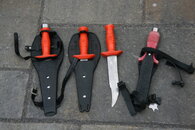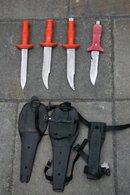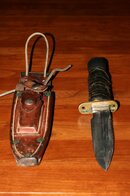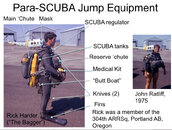I am not one of those who uses a small, DIR knife. I like larger knives with a serrated edge and a straight edge. Over my diving times, I have:
- Sawed through a three-inch line with netting hung up on a ship's prop.
- Cut lines that have tangled on me.
- Cut off two parachutes from the harnesses of two dead Korean pilots who were ejected through their T-33 canopy upon crash landing on a glass-smooth Yellow Sea. Then we recovered their bodies into our HH-43 Huskie helicopters via hoist.
- Numerous times cut heavy fishing line off me.
Because of that, I prefer the Wenoka knife on the right of the photos below of diving knives. The others are ones I have owned over the years from Sportsways, which have Solingen stainless steel and will keep a keen edge (I sharpen my knives myself).
The last knife is a Randall Attack-Survival Knife that I carried during the Vietnam War, and used occasionally (but not for "attack," rather for digging a stuck bullet shell out of a minigun). I like the larger knives as they can be used for many purposes, including digging lead out of the bottom of a river, and like I said, cutting fishing line. There is a reason for the serrations, and that is that a regular blade has a tough time cutting through large rope. I also like the button on the Wenoka knife blade that allows one-handed stowing in my leg sheath.
I carry my knife on the outside of my right leg (when I was in the USAF, it was on the inside of that leg for parascuba jumps--see the photo of Rick Harder and myself below). Also, on parascuba jumps, we usually had two knives, one on the top of our reserve, and the other on our leg.
SeaRat











